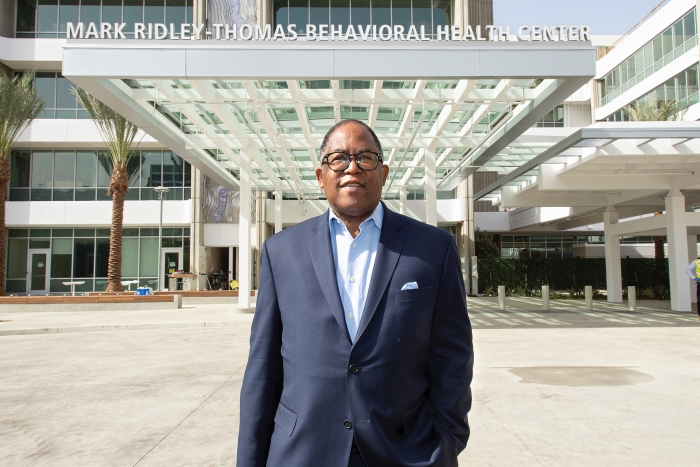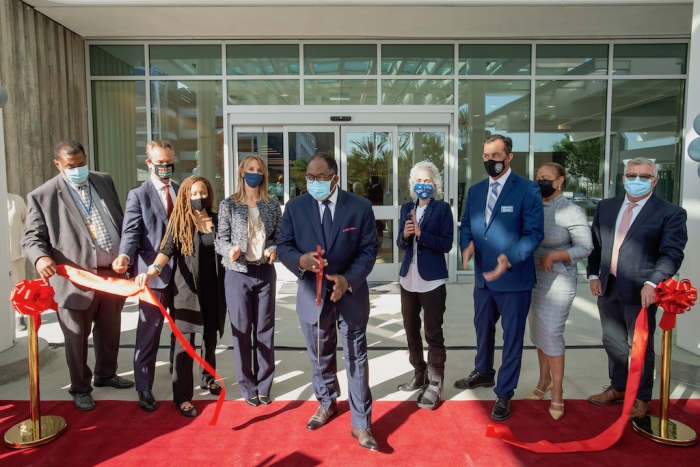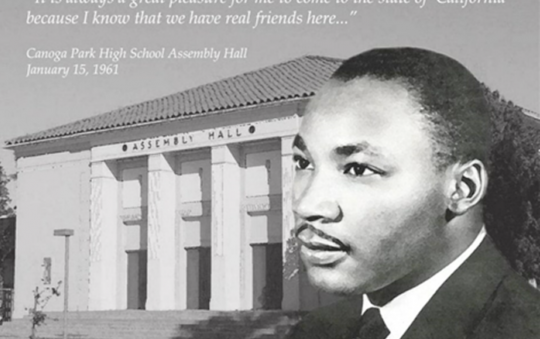More than a decade after its closure, the original Martin Luther King, Jr. Hospital building has completed its transformation to a new and innovative healthcare facility—as the Mark Ridley-Thomas Behavioral Health Center. In a socially-distanced ribbon cutting, Supervisor Mark Ridley-Thomas—in collaboration with several county partners—inaugurated the state’s first ever licensed Behavioral Health Center (BHC) that will provide fully-integrated inpatient, outpatient, and supportive services for some of Los Angeles County’s most vulnerable populations.
“Over the last decade, we have transformed the MLK Medical Campus into a center of excellence that provides holistic care for our community,” said Supervisor Ridley-Thomas. “With the opening of the Behavioral Health Center, we are bringing to life our intent to establish a cutting-edge continuum of care that promotes mental health, recovery, trauma prevention, rehabilitation, and many other essential wrap-around services that foster long-term wellness for our patients and the community at large. I am tremendously proud of this milestone.”
Where the original Martin Luther King, Jr. Hospital once stood, a $335M state-of-the-art facility now stands. The newly renamed Mark Ridley-Thomas Behavioral Center is part of more than one billion dollars invested into the medical campus to transform and support the wellness of surrounding communities. Attendees were able to get an advanced preview of the 500,000-square-foot building that included a new peer resource center, upgraded conference rooms, innovated examination rooms, a new canopy extension, exterior site improvements and more.

“With the County’s $300M plus investment, the BHC will serve the residents of LA County for many years to come with a range of services not found elsewhere. The decision to transform rather than demolish this building has proven to be a very efficient investment of County resources,” said Fesia Davenport, Los Angeles County Acting Chief Executive Officer.
Mark Pestrella, Director of Los Angeles County Public Works agreed, adding, “The transformation of the old hospital is truly astounding. The County’s investment to give life to this amazing building I think is emblematic of the mission the BHC seeks to fulfill. The completion of this transformation into a place of healing and restoration is a poetic outcome for a building that once witnessed tragedy. I am proud of the entire Public Works team and grateful for the Supervisor’s vision that made this happen.”
“Exodus is proud to be a partner in this building providing psychiatric urgent care. Having different levels of behavioral health care available within the same building removes many of the barriers that often deter clients from getting the care that they need,” said Luana Murphy, President and Chief Executive Officer of Exodus Recovery.
As the first of its kind center in the state, the BHC will house more than a half dozen County departments and partners, including clinical and behavioral staff from the Departments of Mental Health, Public Health, Public Works and Health Services. The Departments of Probation and Workforce Development, Aging and Community Services, along with the Office of Diversion and Reentry, will sponsor rehabilitative, vocational and training opportunities to give people the skills they need to reintegrate into society.

“When it comes to mental health, most facilities are not equipped to deliver a full range of behavioral health services that may be required to truly bring healing to someone in need. With an empty building on the MLK Medical Campus, we had a unique opportunity to imagine what it would be like to have a one-stop shop for all behavioral health needs. As the first of its kind in the State of California, I believe the Mark Ridley-Thomas Behavioral Health Center will set the standard for mental health care delivery, but most importantly, bring a new level of healing,” said Dr. Jonathan E. Sherin, Director of the Los Angeles County Department of Mental Health
“The Department of Health Services is excited to collaborate with our mental health partners along with other department to innovate delivery of care. The BHC will provide care for the body and mind, and it is our goal that when someone walks into those doors, they know they are on their way to healing and restoration,” said Dr. Christina Ghaly, Director of the Los Angeles County Department of Health Services.
“We can’t provide substance use disorder services in a vacuum. It has to be delivered in collaboration with mental health, physical health, and spiritual health services. BHC allows us to create a new system of care that would integrate these different systems,” said Dr. Barbara Ferrer, Director of the Los Angeles County Department of Public Health.
Additionally, in a comprehensive effort to create a new paradigm in the delivery of care and healing, significant attention was given to the inclusion of civic art throughout the building from local artists. The exterior art piece, created by artist Cliff Garten, was inspired by water as an image of hope and renewal. The work entitled, Water to Wishes, draws inspiration from the wishes of the community expressed during the community engagement process. The interior piece, designed by Freeland Buck, is a multi-layered mural stitching together photographs of 21 homes from the surrounding Willowbrook community.
In addition to the exterior and interior pieces, another art component that will be integrated into the center is a Martin Luther King, Jr. portrait by renowned painter, Lyle Suter. In 1972, the portrait was misplaced after it was commissioned by the Colonial Savings & Loan Association. The painting was lost for several years until it was recently discovered and restored by the conservators, Aneta Zebala and Suzanne Morris.
“Bringing new life to this building required uplifting and reinvigorating the façade–no better way to do this than with art. The building design lent itself for something dramatic and inspiring, and I couldn’t be more thrilled about the critical role that the arts have played in the transformation of this building. The civic art on the façade and the lobby let you know you have arrived at a safe space where your healing can begin,” said Kristin Sakoda, Director of the Los Angeles County Department of Arts and Culture.
In addition to the building being inaugurated, the main street leading to the building’s doorstep has been renamed Healing Way by a Willowbrook community member in honor of the building’s transformation.
The newly renovated center is anticipated to officially open in the year 2021. For more information and updates, please visit ridley-thomas.lacounty.gov/.








